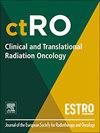第二次立体定向放射治疗难治性三叉神经痛的预后及预测因素
IF 2.7
3区 医学
Q3 ONCOLOGY
引用次数: 0
摘要
目的:本研究评估伽玛刀立体定向放射外科(GKSRS)再治疗(T2)在初始SRS治疗(T1)后复发或难治性三叉神经痛(TN)的安全性和有效性。方法:我们使用前瞻性维护的单一机构数据库,分析了2012年至2018年期间接受T2治疗的53例患者。基线特征、治疗细节和毒性数据进行评估,疼痛反应通过巴罗神经研究所(BNI)疼痛强度评分进行评估。通过单变量和多变量分析确定疼痛复发和慢性感觉毒性的预测因素。结果T2中位最大剂量为70 Gy,主要靶向池段(43 %)和后气区(34 %)。T2后,95% %的患者在1个月的中位反应时间内经历了最初的疼痛缓解,分别有51% %、45% %和41% %的患者在1年、2年和3年内没有疼痛复发。62 %的患者出现慢性感觉缺陷,但运动毒性仍然罕见(咀嚼缺陷:2.5 %;面部运动障碍:5.1% %)。RGZ靶向治疗(HR = 3.84,p = 0.02)和单等中心治疗(HR = 3.85,p = 0.04)与DREZ靶向治疗和两个等中心治疗相比,可预测疼痛复发。影响三叉神经长度<;11.5 mm与慢性感觉缺陷相关(OR = 7.14,p = 0.02)。结论ksrs在难治性/复发性TN再治疗中具有有效的疼痛缓解和可控的毒性。优化参数,包括DREZ靶向和双等中心策略,可以提高疗效,同时平衡治疗时间以减轻慢性感觉毒性。未来的研究应旨在优化治疗参数,以最大限度地减轻疼痛,同时尽量减少对这些患者的毒性。本文章由计算机程序翻译,如有差异,请以英文原文为准。
Outcomes and predictive factors after second stereotactic radiosurgery for refractory trigeminal neuralgia
ObjectivesThis study evaluates the safety and efficacy of Gamma Knife Stereotactic Radiosurgery (GKSRS) retreatment (T2) for recurrent or refractory trigeminal neuralgia (TN) following an initial SRS treatment (T1).
Methods
We analyzed 53 patients who underwent T2 between 2012 and 2018 using a prospectively maintained single institution database. Baseline characteristics, treatment details, and toxicity data were assessed, with pain responses evaluated via Barrow Neurological Institute (BNI) pain intensity scores. Predictors of pain recurrence and chronic sensory toxicity were identified using univariate and multivariable analyses.
Results
The median T2 maximum dose was 70 Gy, primarily targeting the cisternal segment (43 %) and retrogasserian zone (RGZ) (34 %). Following T2, 95 % experienced initial pain relief with a 1-month median time to response, and 1-, 2-, and 3-year freedom from pain recurrence of 51 %, 45 %, and 41 %, respectively. Chronic sensory deficits were observed in 62 % of patients, but motor toxicity remained rare (mastication deficit: 2.5 %; facial motor deficit: 5.1 %). RGZ targeting (HR = 3.84, p = 0.02) and single isocenter treatments (HR = 3.85, p = 0.04) were predictive of pain recurrence when compared to dorsal root entry zone (DREZ) targeting and two isocenters, respectively. Affected trigeminal nerve length <11.5 mm was associated with chronic sensory deficits (OR = 7.14, p = 0.02).
Conclusion
GKSRS provides effective pain relief and manageable toxicity in retreatment for refractory/recurrent TN. Optimizing parameters, including DREZ targeting and dual-isocenter strategies, can enhance outcomes, while balancing treatment length to mitigate chronic sensory toxicity. Future research should aim at optimizing treatment parameters to maximize pain relief while minimizing toxicity for these patients.
求助全文
通过发布文献求助,成功后即可免费获取论文全文。
去求助
来源期刊

Clinical and Translational Radiation Oncology
Medicine-Radiology, Nuclear Medicine and Imaging
CiteScore
5.30
自引率
3.20%
发文量
114
审稿时长
40 days
 求助内容:
求助内容: 应助结果提醒方式:
应助结果提醒方式:


